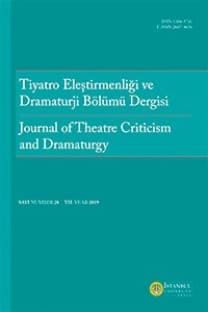Bir Geleneğin Çevirisi: Tanzimat Dönemi Türkçe Molière Çevirilerinde Osmanlı Halk Tiyatrosu Öğeleri
Molière tiyatrosu homojen, tek kaynaktan çıkmış, bugün anladığımız anlamda “özgün” metinlerden oluşmaz. Çok katmanlı bir malzeme üzerine kuruludur ve girift bir yapıya sahiptir. Bu tiyatro on dokuzuncu yüzyılın başlarından itibaren Türkçeye çevrilmeye başlandığında, farklı tarihsel dönem ve kültürlere ait tiyatro geleneklerinden beslenmiş bir gelenekle, Karagöz ve Ortaoyunu’ndan oluşan halk güldürüsüyle karşılaşır. Molière tiyatrosuyla Osmanlı halk tiyatrosu arasında beslendikleri kaynaklar açısından yadsınamayacak ortaklıklar vardır. 1869-1882 yılları arasında Molière’i Türkçeye çeviren, uyarlayan ya da Türkçede yeniden yazanlar da bu iki tiyatro geleneği arasındaki paralellikleri öne çıkartmış, Fransız tiyatro adamının Osmanlı seyircisine en tanıdık gelebilecek oyunlarını kaynak metin olarak seçip yine Karagöz ve Ortaoyunu’yla büyümüş seyirciye en tanıdık gelebilecek şekilde Türkçeye çevirmek için gerekli müdahaleleri yapmakta sakınca görmemiştir.
Translation of a Tradition: Elements of Ottoman Popular Theater in the Turkish Translations of Molière in the Tanzimat Era
Molière’s plays aren’t composed of homogeneous, single-source, or “original” (original in the sense we would understand the term today) texts. They are built on multi-layered material with an intricate structure. When these plays were first translated into Turkish in the first half of the 19th century, they were translated into a context with a preexisting popular comedy tradition consisting of Karagöz and Ortaoyunu, which were influenced by different theater traditions from various historical periods and cultures. But there are undeniable similarities between Molière’s plays and Ottoman popular theater in terms of the resources they draw from. The translators, adapters or rewriters of Molière into Turkish between 1869-1882 highlighted these parallels between the two theater traditions, choosing as the source text the plays of the French playwright that would be most familiar to Ottoman audiences. They went to considerable lengths to translate these comedies in a way that would keep them familiar to Ottoman audiences who grew up with Karagöz and Ortaoyunu.
Keywords:
Translation, Comedy,
___
- Ahmet Vefik Paşa (çev.). Zor Nikâhı. Haz. Mustafa Nihat Özön. İstanbul: Remzi Kitabevi, 1970. google scholar
- Âli Bey (çev.). Ayyar Hamza. Haz. Mustafa Nihat Özön. İstanbul: Remzi Kitabevi, 1968. google scholar
- And, Metin. Geleneksel Türk Tiyatrosu. İstanbul: İnkılâp Kitabevi, 1985. google scholar
- And, Metin. Osmanlı Tiyatrosu. Ankara: Dost Kitabevi Yayınları, 1999. google scholar
- And, Metin. Şair Evlenmesi’nden Önceki İlk Türkçe Oyunlar. İstanbul: İnkılâp ve Aka, 1983. google scholar
- And, Metin. Tanzimat ve İstibdat Döneminde Türk Tiyatrosu (1839-1908). Ankara: Türkiye İş Bankası Kültür Yayınları, 1972. google scholar
- And, Metin. “Tiyatroda ‘Açık Biçim’ ve Türk Tiyatrosu Bakımından Önemi”, Tiyatro Araştırmaları Dergisi 1 (1970), 19-31. google scholar
- Bourqui, Claude. Les Sources de Molière. Répertoire critique des sources littéraires et dramatiques. Paris: Sedes, 1999. google scholar
- Claretie, Léo. “Bucarest Moderne.” Revue Illustrée, 20 Aralık 1906, 379-386. google scholar
- Even-Zohar, Itamar. « The Position of Translated Literature within the Literary Polysystem », The Translation Studies Reader. Ed. Lawrence Venuti, 192-197. Londra ve New York: Routledge, 2004. google scholar
- Forestier, Georges ve Bourqui, Claude. “L’Avare/Notice”/Molière’in OEuvres complètes II (Haz. Georges Forestier ve Claude Bourqui) kitabına açıklama, 1313-1334. Paris: Éditions Gallimard, 2010. google scholar
- Karaboğa, Kerem. “Molière’in Yolculuğu”, İBB Arşivlerinde Molière’den Molyer’e” Sergi Kataloğu. Haz. Özde Nalan Köseoğlu ve Reha Keskin, 27-28. İstanbul: İBB Basın Yayın Şube Müdürlüğü Basımevi, 2022. google scholar
- Kudret, Cevdet. Ortaoyunu, cilt I. İstanbul: YKY Yay., 2019. google scholar
- Kurt Williams, Çiğdem. “Chambord Şatosu’ndan Osmanlı Sahnelerine Taşınan Şamata: Yirmi Çocuklu Bir Adam yahut Fettan Zaman İnsana Neler Yapmaz”, Tiyatro Eleştirmenliği ve Dramaturji Bölümü Dergisi 29 (2019), 1-15. google scholar
- Michel, Lise ve Bourqui, Claude. “Le Médecin Malgré Lui/Notice”/Molière’in OEuvres complètes I (Haz. Georges Forestier ve Claude Bourqui) kitabına açıklama, 1465-1474. Paris: Éditions Gallimard, 2010. google scholar
- Molière. “L’Avare”, OEuvres complètes II. Haz. Georges Forestier ve Claude Bourqui, 1-73. Paris: Éditions Gallimard, 2010. google scholar
- Molière. “L’Avare/Notes”/Notlar Bölümü, OEuvres complètes II. Haz. Georges Forestier ve Claude Bourqui, 1335-1346. Paris: Éditions Gallimard, 2010. google scholar
- Molière. “Les Fourberies de Scapin”, OEuvres complètes II. Haz. Georges Forestier ve Claude Bourqui, 367-419. Paris: Éditions Gallimard, 2010. google scholar
- Molière. “Le Mariage forcé”, OEuvres complètes I. Haz. Georges Forestier ve Claude Bourqui, 935-959. Paris: Éditions Gallimard, 2010. google scholar
- Molière. “Sganarelle ou le cocu imaginaire”, OEuvres complètes I. Haz. Georges Forestier ve Claude Bourqui, 38-81. Paris: Éditions Gallimard, 2010. google scholar
- Pekman, Yavuz. Çağdaş Tiyatromuzda Geleneksellik. İstanbul: Mitos & Boyut Yay., 2002. google scholar
- Saraç, Tahsin. Fransızca-Türkçe Büyük Sözlük I (A-K). Ankara: TDK Yay., 1976. google scholar
- Tahir Gürçağlar, Şehnaz. Çevirinin ABC’si. İstanbul: Say Yayınları, 2019. google scholar
- Teodor Kasap (çev.). İşkilli Memo. Haz. Cevdet Kudret. İstanbul: Elif Yayınları, 1965. google scholar
- Teodor Kasap (çev.). Pinti Hamid. İstanbul: Yayıncı yok, 1290/1873. google scholar
- Yaman, Belkıs. «1869-1876 Yılları Arasında Yayınlanan Mizah Gazetelerinde Tiyatro», Yüksek Lisans Tezi, İstanbul Üniversitesi, 1994. google scholar
- ISSN: 1303-8605
- Yayın Aralığı: Yılda 2 Sayı
- Başlangıç: 2002
- Yayıncı: İstanbul Üniversitesi
Sayıdaki Diğer Makaleler
Tamer Can ERKAN, Hakkı Alper MARAL
Mine Söğüt’ün Beş Sevim Apartmanı Romanının Tiyatro Uyarlamalarına Çeviribilim Perspektifinden Bakış
Kamyon Oyununda Yabancılaşma ve Gündelik Hayat Ritimleri
Melike BOZDOĞAN, Özge BOZDOĞAN
Oyun Metinlerinde Ritim ve Bir Örnek Olarak Molière’in Cimri’sinin Ritimanalizi
Tiyatro Alanında Bilimsel Yayınlar: Uluslararası Tiyatro Çalışmalarının Bibliyometrik İncelemesi
Eski Yunan Tiyatrosu ve Agon Kültürü
İran Tiyatrosu’nda Modern Bir Matem Töreni: Şehr-i Kıssa
Bir Geleneğin Çevirisi: Tanzimat Dönemi Türkçe Molière Çevirilerinde Osmanlı Halk Tiyatrosu Öğeleri
Nathan Ellis'in Oyunu Work.Txt'de Medyanın İzleyici ve Metin Üzerindeki Rolü
